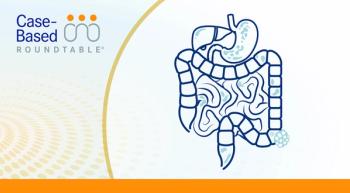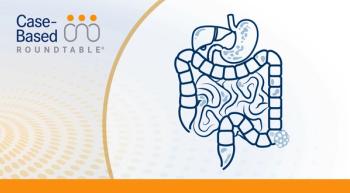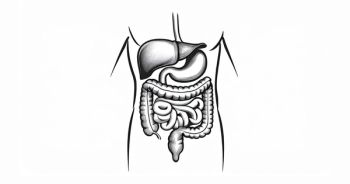
PD-L1 CPS Plays Role in Selecting Treatment for Gastric Cancer
During a Targeted Oncology case-based roundtable event, Syma Iqbal, MD, discussed the addition of nivolumab to chemotherapy for patients with gastric/gastroesophageal junction cancer based on PD-L1 status. This is the second of 2 articles based on this event.
CASE SUMMARY
A 60-year-old man presented with abrupt 10-pound weight loss, dyspepsia, bloating after meals, and loss of appetite, with all symptoms worsening over the past 3 months. His father died of gastric cancer at 50 years old.
The patient was overweight, with Barrett esophagus. Esophagogastroduodenoscopy showed a 2-cm protruding mass in the body of the stomach, without ulceration. A biopsy revealed poorly differentiated adenocarcinoma. Molecular testing showed he was HER2/neu–negative; mismatch repair proficient/microsatellite stable; PD-L1 combined positive score (CPS) 5; and NTRK alteration negative.
A CT scan of the abdomen and chest revealed a gastric polypoid mass and thickening; no ascites; 2 lesions in the left lung lower lobe. Lung biopsy confirmed metastatic adenocarcinoma consistent with gastric primary. PET/CT scan confirmed metastatic disease. He received a diagnosis of stage IV gastric adenocarcinoma and was started on FOLFOX (folinic acid, 5-fluorouracil, and oxaliplatin) plus nivolumab (Opdivo).
DISCUSSION QUESTIONS
- Do you agree with the choice of first-line nivolumab plus FOLFOX for this patient?
- At what PD-L1 expression threshold do you consider adding an immune checkpoint inhibitor to chemotherapy for HER2- advanced/metastatic gastric/gastroesophageal junction (GEJ) cancers?
- What if the patient in our case had a PD-L1 CPS of 3 or 4 instead of 5? What would you most likely recommend as first-line therapy?
- What if the PD-L1 testing had not been performed or was unknown for some reason? Would you have initiated nivolumab plus chemotherapy or order a PD-L1 test (if tissue available/accessible) before starting nivolumab?
SYMA IQBAL, MD: Do you agree with the first choice, nivolumab and FOLFOX? And then what do you think about the CPS score? Would you treat a [patient with a] CPS score of less than 5?
SHIVEN PATEL, MD: The data were presented in a clever way to get it approved for all comers, but they weren’t presented specifically for the subgroups.1 Looking at the [Kaplan-Meier] curves [for overall survival for patients with CPS of at least 1 versus all patients], there are clearly those with CPS greater than 5 who created the benefit in all comers and in those with CPS greater than 1. I think if you had specific charts looking at the CPS 1 to 4 and the CPS less than 1—which would be small numbers, underpowered—I don’t think you’d see any benefit in those with CPS less than 1, and I think those with CPS 1 to 4 would be questionable. I still offer it if [their CPS score is] greater than 1.
IQBAL: There have been retrospective data presented looking at those low CPS scores from CheckMate 649 [NCT02872116]. You’re absolutely right. This study was enriched. Surprisingly, I think it was at least 60% of patients who had a CPS score of 5 or greater, so it skewed the all-comers. But it looks like that those patients whose CPS was less than 5 didn’t appear to benefit from the addition of the immunotherapy in some of these retrospective evaluations of these low scores.2
ADITI CHOUDHRY, MD: Do you think the FDA might change the on-label indication? Because patients ask about that. The on-label is for everybody. It’s for all comers.
PATEL: It was an accelerated approval so they can change it down the road just like they took away the…indications [for pembrolizumab (Keytruda)].3
IQBAL: I’m sure it will get reviewed. They did take away the third-line indication for single-agent [pembrolizumab], so there may be some revision to the FDA label [for nivolumab].
CHOUDHRY: What do you do in your practice, Dr Iqbal?
IQBAL: I do what’s been described. If they have a CPS score of 5 or greater, they get immunotherapy. If they’re between 1 and 4, even though the retrospective data shows that they probably aren’t benefitting, I do tend to use it in my practice. If their CPS is 0, I don’t use it at all.
CHOUDHRY: What do you do with somebody with squamous histology, CPS of 1 and TMB [tumor mutational burden] of 8? Would you use it?
IQBAL: Yes, for a CPS of 1 or greater in squamous [disease] I use it.
VANDANA AGARWAL, MD: How immunogenic are GEJ cancers? There are 2 tumor types which are highly immunogenic: melanoma and renal cell carcinoma. But GEJ cancers are not more immunogenic.
IQBAL: Not in the way that we’re seeing in the tumors you’ve described, but it’s [one of] the first things that we’ve been able to add to our armamentarium of treating these patients. Besides trastuzumab [Herceptin] and ramucirumab [Cyramza], we haven’t had anything to add to chemotherapy, and the addition of immunotherapy clearly benefits some patients. I do tend to use it. Are you finding limitations of getting it in your practice, based on CPS score?
AGARWAL: No.
IQBAL: What if you didn’t know the CPS score? What if you didn’t know the PD-L1 status of the patient?
AGARWAL: Then it’s difficult. We can’t get approval. If the CPS score is not available or PD-L1 or TMB is not there, then unless it’s a private insurance, it’s very difficult to get reimbursed or approved from the Health Maintenance Organizations.
DISCUSSION QUESTIONS
- For how long do you, or should you, continue nivolumab?
- What are the options for next-line therapy for this patient?
- Given the high proportion of patients who do not go on to receive more than 1 line of therapy, how important is using the most effective therapy first?
- What do you view as the ideal scenario(s)/line of therapy for use of an immune checkpoint inhibitor for a patient with HER2- advanced/metastatic gastric or GEJ cancer?
IQBAL: How long do you continue therapy with nivolumab?
AGARWAL: One year or until progression or intolerance.
CHOUDHRY: Two years or until progression or intolerance.
ELIE FAHED, MD: Usually 2 years, but I don’t think I have had to make that decision yet.
NEEL TALWAR, MD: I would continue indefinitely until progression or toxicity. I think the issue is more the oxaliplatin; how long do you give that? Usually, I give 8 cycles of FOLFOX and nivolumab and then drop the oxaliplatin and keep them on maintenance 5-fluorouracil and nivolumab.
IQBAL: I think that’s a common practice. Many of the trials that are being designed now have accepted that as a standard approach, and extrapolating from the colon cancer data and dropping the oxaliplatin and continuing with the maintenance therapy plus the nivolumab.
FAHED: Is there a tail on the [Kaplan-Meier] curve? [Are] there any long responders?
IQBAL: There are tails on all these immunotherapy [Kaplan-Meier] curves. That is what we’re looking for in all these patients, to find that tail patient. In terms of how long to treat these patients, CheckMate 649 was 2 years. You’re lucky to have this problem, but I also usually continue until disease progression. [That is] something to keep in mind.
DIANA HANNA, MD: [I continue] usually until 2 years and then for that rare patient, I have a discussion with them if they want to continue or stop.
IQBAL: Yes. I think it’s also interesting we brought up the third-line [pembrolizumab] data where the FDA approval was retracted, if you will, based on ODAC’s [Oncologic Drugs Advisory Committee’s] recommendation. This [essentially] is the only opportunity to potentially expose patients to immunotherapy. The majority of patients don’t go on to second-line treatment. Does that affect your decision to use immunotherapy up front?
FAHED: To a degree it does. I always consider I have one shot at the goal here, and whatever I pick for my first line, [it is] probably very unlikely that I’ll go to second line. So I tend to use a lot of combinations based on FDA approval, chemoimmunotherapy and trastuzumab if the patient is HER2 positive.
REFERENCES
1. Janjigian YY, Shitara K, Moehler M, et al. First-line nivolumab plus chemotherapy versus chemotherapy alone for advanced gastric, gastro-oesophageal junction, and oesophageal adenocarcinoma (CheckMate 649): a randomised, open-label, phase 3 trial. Lancet. 2021;398(10294):27-40. doi:10.1016/S0140-6736(21)00797-2
2. Shitara K, Janjigian YY, Moehler M, et al. Nivolumab (NIVO) plus chemotherapy (chemo) versus chemo as first-line (1L) treatment for advanced gastric cancer/gastroesophageal junction cancer/esophageal adenocarcinoma (GC/GEJC/EAC): Expanded efficacy, safety, and subgroup analyses from CheckMate 649. J Clin Oncol. 2022;40(4_suppl):240. doi:10.1200/JCO.2022.40.4_suppl.240
3. Merck provides update on Keytruda® (pembrolizumab) indication in third-line gastric cancer in the US. Merck. July 1, 2021. Accessed November 16, 2022. https://bit.ly/3tBF9Hs









































